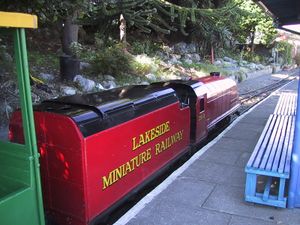Lakeside Miniature Railway
The Lakeside Miniature Railway, runs alongside the Marine Lake on the sea front at Southport, it is of 15 in (381 mm) gauge and is representative of many miniature pleasure railways which sprung up in the early 1900s.
Route
The line originally consisted of a straight running line on the seaward shore of the Southport Marine lake with a run-round loop at each end. In 1918 the original straight up and back track was extended round a sharp reverse curve under Southport pier through 90 degrees into the present terminus at Marine Parade Station. This layout remains today with the round trip covering about 1.5km. At the Pleasureland end of the line there is a loco shed / Workshop and a second, larger locomotive shed. The station at this end of the line has a single island platform serving two running lines with run round loops which converge to form the single line route which runs alongside the lake, there is also a third siding for stock storage. At the pier end of the line there are two platforms again serving to running lines with run round loops, the station building at this end of the line has recently been rebuilt.
History
The railway was built in 1911 along the seaward side of the Marine lake, Southport, England. The First Train ran on 25th May 1911. The builder and operator was a Mr. G.V. Llewellyn and hence the railway was originally named Llewellyn's Miniature Railway. The line was originally built with raw materials being provided by the model engineering business Bassett-Lowke and in 1938 the original route was extended round to form an 'L' shape with the new terminus running parallel to the pier. Closing Princes Park Station and Opening the new Marine Parade Station. In 1945 the railway was sold to Harry Barlow and in 2001 to the present owner Don Clark. The railway is now called the Lakeside Miniature Railway and still runs on the 1911 route with the later extension. It is one of the earliest railway of its type still running on its original route. The only other Line is Rhyl Miniature Railway which opened 1st May 1911. Rhyl Closed during the war but Lakeside Miniature Railway remained open making Lakeisde the oldest continually running railway.
Locomotives
The line originally had two steam locomotive of the Bassett-Lowke Class 10 ‘Atlantic’ 4-4-2 design, named King George and Princess Elizabeth, these locos were later supplemented by Katie, an 0-4-0 side tank built by that pioneer of the minimum gauge Sir Arthur Heywood. Where the two Bassett-Lowke locomotives had been supplied new Katie was third hand having already worked on the Eaton Estate Railway and the Ravenglass and Eskdale line Cumbria. She did not spend long at Southport, arriving in 1919 and being sold on again in 1923 to the Fairbourne Miniature Railway.
The Bassett-Lowke locos were sufficient for the original trains but as Southport increased in popularity as a holiday location trains became busier and the locos were rebuilt to the larger class 30 standard.
In 1948 the railway’s motive power took a step towards the future with the building of a petrol-electric loco of 4-6-2 wheel arrangement with a tender, built to look like Gresley’s famous LNER Class A4 locomotives. The loco was built in Southport by a Mr. Harry Barlow who had taken over the railway in 1945.
The original locomotive of this type was named Duke Of Edinburgh with Prince Charles following in 1954 and Golden Jubilee in 1963. Golden Jubilee, although of the same basic design of the other two lost the A4 styling replaced by a box-shaped body and a loss of the steam outline wheels, the wheel arrangement being modified to 4-6-0 configuration. This loco though not as attractive as the former Barlow locos is not aesthetically displeasing.
All three of these Barlow locos still exist on the railway there fordson tractor petrol engines having been replaced by more modern economical diesels.
In 1971 another loco joined the fleet, a Severn and Lamb product built to look like a Western Diesel, the wheel configuration being Co-Co and the drive being Diesel-Hydraulic.
A little known loco which ran on the line was a small 0-4-0 petrol mechanical shunter; No 14. Built for the line by a Mr. Gordon Walker in 1985 using a 1000cc Austin engine and a hudson coach bogie No 14 was designed for permanent way work though it could in fact haul 6 of the lines articulated coaches. It was not successful mainly because of the crude belt drive and was moved in 1990, being acquired by Austin Moss of the Windmill Farm Railway.
In 2005 a new locomtive was commisioned for the railway and in 2006 the new 2-6-2 steam-outline diesel hydraulich was delivered form Windmill Farm. It is a sit-in locomotive with an overall cab for the driver and is of tank engine apperance. It has been named Jenny.

